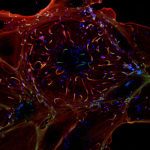About
What are the central components of polarity pathways ? Are they affected during gliomagenesis?
- Using astrocyte directed migration as a model system, we have identified evolutionary conserved polarity signals that control cell polarity and in particular, demonstrated the role of Cdc42 in front-torear polarization of migrating cells (Etienne-Manneville et al, 2001, 2003, 2004 & 2005) – We have demonstrated the role of the polarity protein Scrib (scribble) in the recruitment and activation of Cdc42 at the cell leading edge (Osmani, 2006).
- We have shown the role of intracellular traffic in controlling Cdc42 activation and cell polarization (Osmani, 2010). We are now investigating how alterations of polarity proteins in glioblastoma cells can affect cell polarity and migration. Expression of GFP-Cdc42 in migrating astrocytes shows Cdc42 association with intracellular membranes and its polarized recruitment to the cell leading edge.
1/ SCRIB, a polarity gene controlling the cytoskeleton (Batiste Boëda, INSERM)
The SCRIB gene, conserved from invertebrates to mammals, plays a major role in many cellular functions such as cell polarity, cell migration and cell proliferation. Abnormal cellular expression of SCRIB is often associated with poor cancer prognosis, placing SCRIB in the family of tumor suppressor genes.
In the lab we study the SCRIB gene using CRISPR/Cas9 and Organ on chip technologies with a specific focus on its putative role on the cytoskeleton and cell shape.
2/ Role of the tumor suppressor PTEN during directed and collective cell migration (Florent Peglion, Post-Doc)
PTEN is one of the most frequently mutated tumor suppressor gene in cancer, specifically in invasive cancers such as glioblastomas. However its function in collective cell migration and invasion is not fully characterized. Using in vitro 2D wound-healing assay, 3D gel invasion assay and intravital imaging in zebrafish, we investigate the impact of PTEN loss on cell polarity, migration and invasion. In particular we aim at deciphering how PTEN regulates the actin cytoskeleton and cell-cell interactions to maintain cohesion during collective cell migration and prevent chaotic dissemination of the cells.
These findings and the use of a newly developed xenotransplation assay in zebrafish brain will help us understand why PTEN-negative glioblastoma cells invade so efficiently the brain of the patients and will pave the way to most expected new therapeutics to counter glioblastoma progression.





